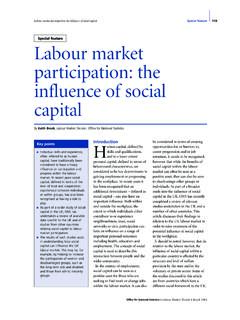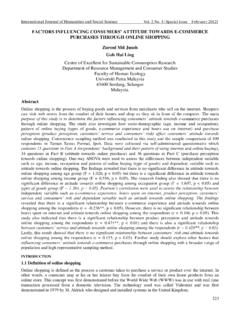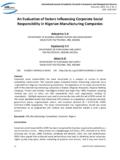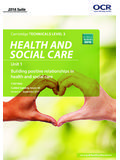Transcription of relationship Marketing Theory - Jeffrey Heilbrunn
1 relationship MarketingROBERT W. PALMATIERMARKETING SCIENCE INSTITUTEC ambridge, MassachusettsContentsForeword AcknowledgmentsExecutive SummaryIntroductionA Theoretical Perspective of RelationshipMarketing 1 What Is relationship Marketing ?DefinitionOverlap with Other Marketing DomainsHistorical Perspective2 How Does relationship Marketing Work?Evolution of relationship Marketing TheoryInterfirm relationship Marketing TheoryInterpersonal relationship Marketing TheoryMultilevel Relationships3 How Do Relationships Change over Time? relationship Lifecycle StagesDynamic View of RelationshipsAn Applied Perspective of RelationshipMarketing 4 Understanding relationship Marketing s Financial Impact Linking relationship Marketing to Financial OutcomesMeasuring Relationships and Financial ImpactCopyright 2008 Robert W.
2 PalmatierPublished by Marketing Science Institute, 1000 Massachusetts Ave.,Cambridge, MA 02138 Printed in the United States of AmericaISBN 0-9657114-9-8 All rights reserved. No part of this book may be reproduced, in any form orby any means, electronic or mechanical, without permission in writing fromthe Institute and the authors. ForewordThe 2006-08 MSI research priorities were given the title, The ConnectedCustomer, to reflect the increasing importance of understanding how cus-tomers and the firm interact before making key Marketing decisions. Nothingis more fundamental to understanding these interactions than an analysis of theunderlying relationships that either have been built or have the potential to bebuilt between customers and this monograph, relationship Marketing , the seventh in our RelevantKnowledge Series, Robert Palmatier of the University of Washington brings hisoutstanding combination of senior executive and academic experience to bearon this critical Marketing issue, and takes both a theoretical and applied look atthe relationship between buyer and much of the attention to relationship Marketing has been on financialissues such as measuring lifetime value and managing loyalty programs.
3 Palmatier takes a more strategic perspective by emphasizing the importance ofaligning a company s business strategy with its relationship Marketing addition, he stresses the fact that Marketing investments should be focusedon what he calls social programs communications activities between buyerand seller and structural programs policies and procedures establishedbetween the parties such as electronic ordering and inventory replenishing sys-tems. Palmatier notes that these kinds of programs are more effective in estab-lishing and maintaining long-term customer relationships than financially ori-ented Marketingoffers useful perspectives to both academicresearchers interested in better understanding the conceptual underpinnings ofrelationships and managers seeking to build effective relationships with cus-tomers.
4 We are very pleased to add it to our Relevant Knowledge Series and wethank Robert Palmatier for his S. WinerNew York UniversityMSI Executive Director 2007-09 5 Building and Maintaining Strong RelationshipsDrivers of Customer RelationshipsRelationship Marketing ProgramsOrganizational Elements and Business Processes6 Targeting and Adapting relationship Marketing StrategiesCustomer Factors Seller Factors Multilevel relationship Factors Environmental Factors 7 Enhancing Performance through Best Practice How to Build and Maintain Strong Customer RelationshipsHow to Adapt and Target relationship Marketing8 Future Research Directions and Topics Measuring Relational AssetsRelationship AntecedentsRelationship OutcomesMultilevel and Intergroup RelationshipsNegative Effects of relationship MarketingRelationship
5 DynamicsRelationship Marketing Boundary Conditions and Context EffectsRelationship Marketing TheoryAlternative Research MethodsGlossaryAppendixNotesReferencesAb out the Author About MSI Related MSI Working Papers n Executive SummaryRelationship Marketing and customer relationship management have taken acentral position in Marketing strategy in the past two decades. A confluence offactors, including the transition to service-based economies; advances in com-munication, logistics, and computing technologies; increased global competi-tion; and faster product commodization have enhanced the salience of rela-tionship-based loyalty to sellerscompared with other Marketing mix , some of these trends are simultaneously increasing customers desirefor the unique characteristics found in relationship -based exchanges ( ,reduced perceived risk, higher trust, enhanced cooperation, and greater flexibil-ity).
6 Thus, in many situations, both sellers and customers are becoming moreinterested in conducting business transactions embedded within firms who use or wish to use relationship Marketing in their busi-ness, the primary question is, How can relationship Marketing be implementedto improve customer loyalty and seller s sales and profits? Several importantmanagerial takeaways, discussed at length in the monograph, are ConflictThe factor with the most significant impact on customer relationship quality isunresolved conflict. Existing research clearly demonstrates that conflictbetween sellers and customers can quickly wreak havoc destroying trust,commitment, and, ultimately, a relationship built through many years of invest-ment.
7 To avoid and reduce conflict, selling firms must ensure that their businessprocesses are aligned to their relationship Marketing strategy. The company cul-ture must emphasize the importance of resolving conflict, and must instituteformal systems for correcting customer issues. AcknowledgmentsI would like to acknowledge my coauthors, Rajiv P. Dant, Robert F. Dwyer,Kenneth R. Evans, Eric Fang, Srinath Gopalakrishna, Dhruv Grewal, AbbieGriffin, Mark B. Houston, Cheryl Burke Jarvis, Frank R. Kardes, VijaykumarKrishnan, Lisa K. Scheer, and Jan-Benedict E. M. Steenkamp, all of whom havecontributed to many of the ideas and findings represented in this work. I alsoappreciate the support that the Marketing Science Institute (MSI) and theInstitute for the Study of Business Marketing (ISBM) have given me for manyof the primary research projects on which this monograph draws.
8 N term relational loyalty. In the worst cases, financial programs can negativelyimpact customer-seller relationships depending on the accompanying messageon who and why the benefit is being the CustomerSellers relationship Marketing returns can be enhanced by better understand-ing the customer s perspective. In particular, selling firms that can measure andappreciate their customers relationship orientation that is, their need anddesire for a relationship can enjoy significant benefits. If a customer has a lowneed ( , low relationship orientation), relationship Marketing investmentswill not only generate poor returns but can actually damage the exchange byincreasing customer perceptions of hassles and exchange , a customer with high relationship orientation one who bothwants and needs a close relationship represents the very best target for rela-tionship Marketing .
9 A number of factors are shown to increase a customer srelationship orientation. Industry relational norms, customer relational-centricreward systems, product dependence and involvement, and any factors increas-ing a customer s uncertainty or risk will increase a customer s relationship ori-entation and thus, a seller s relationship Marketing and How to Implement ProgramsTo leverage its relationship Marketing investments, a seller should time a rela-tionship Marketing benefit to when the customer s need is at its peak, and towhen that benefit will provide the most value. Moreover, designing programs toincrease customers' perceptions of the seller's free will, benevolence, risk, andcost in providing the benefits will influence customer and managing gratitude and its role in building and main-taining reciprocity norms appears to play an important part in effective rela-tionship Marketing .
10 Grateful customers are psychologically hardwired to feelthe need to reciprocate. Sellers should give customers an opportunity to recip-rocate soon after receiving a RM benefit, which takes advantage of high levels ofgratitude, prevents guilt rationalization, and leads to the formation of reciproc-ity norms. Ensuring that programs have some random or discretionary elementis important, otherwise the program becomes integrated into the overall valueThe Role of Boundary SpannersThe individual boundary-spanning personnel with whom customers interfaceoften represent the most critical vehicle for building and maintaining strongcustomer relationships. In many cases, a firm s primary relationship marketinginvestment should go toward hiring, training, and continually motivatingboundary-spanning employees.






